Different Household Livelihood Strategies and Influencing Factors in the Inner Mongolian Grassland
Abstract
1. Introduction
2. Study Site
3. Methods
3.1. Data Collection
3.2. Data Analysis
3.2.1. Classifying Households Based on Their Livelihood Strategies
3.2.2. Income Differences and Its Influencing Factors
3.2.3. Identifying the Influencing Factors of Household Livelihood Strategies
4. Results
4.1. Classification of Household Livelihood Strategies
4.2. Income Differences and Its Influencing Factors
4.3. Influencing Factors of Household Livelihood Strategies
5. Discussion
5.1. The Differences of Household Livelihood Strategies and Influencing Factors
5.2. Implications for Grassland Management and Sustainable Development
6. Conclusions
Author Contributions
Funding
Acknowledgments
Conflicts of Interest
References
- Ellis, F. Rural Livelihoods and Diversity in Developing Countries; Oxford University Press: Oxford, England, 2000. [Google Scholar]
- Zhao, Y.Y.; Yan, Y.Z.; Liu, Q.F.; Li, F.Y.H. How Willing Are Herders to Participate in Carbon Sequestration and Mitigation? An Inner Mongolian Grassland Case. Sustainability 2018, 10, 2808. [Google Scholar] [CrossRef]
- Ashley, C.; Carney, D.; Ashley, C.; Carney, D. Sustainable Livelihoods: Lessons from Early Experience; Department for International Development: London, UK, 1999. [Google Scholar]
- Rakodi, C. A Capital Assets Framework for Analysing Household Livelihood Strategies: Implications for Policy. Dev. Policy Rev. 1999, 17, 315–342. [Google Scholar] [CrossRef]
- Li, A.; Wu, J.G.; Zhang, X.F.; Xue, J.G.; Liu, Z.F.; Han, X.G.; Huang, J.H. China’s new rural “separating three property rights” land reform results in grassland degradation: Evidence from Inner Mongolia. Land Use Policy 2018, 71, 170–182. [Google Scholar] [CrossRef]
- Zhang, X.F.; Niu, J.M.; Buyantuev, A.; Zhang, Q.; Dong, J.J.; Kang, S.R.L.; Zhang, J. Understanding Grassland Degradation and Restoration from the Perspective of Ecosystem Services: A Case Study of the Xilin River Basin in Inner Mongolia, China. Sustainability 2016, 8, 594. [Google Scholar] [CrossRef]
- Alexander, S.; Aronson, J.; Whaley, O.; Lamb, D. The relationship between ecological restoration and the ecosystem services concept. Ecol. Soc. 2016, 21. [Google Scholar] [CrossRef]
- Dong, X.B.; Dai, G.S.; Ulgiati, S.; Na, R.S.; Zhang, X.S.; Kang, M.Y.; Wang, X.C. On the Relationship between Economic Development, Environmental Integrity and Well-Being: The Point of View of Herdsmen in Northern China Grassland. PLoS ONE 2015, 10. [Google Scholar] [CrossRef]
- Lindenberg, M. Measuring household livelihood security at the family and community level in the developing world. World Dev. 2002, 30, 301–318. [Google Scholar] [CrossRef]
- Singh, P.K.; Hiremath, B.N. Sustainable livelihood security index in a developing country: A tool for development planning. Ecol. Indic. 2010, 10, 442–451. [Google Scholar] [CrossRef]
- Soltani, A.; Angelsen, A.; Eid, T.; Naieni, M.S.N.; Shamekhi, T. Poverty, sustainability, and household livelihood strategies in Zagros, Iran. Ecol. Econ. 2012, 79, 60–70. [Google Scholar] [CrossRef]
- Yletyinen, J.; Hentati-Sundberg, J.; Blenckner, T.; Bodin, O. Fishing strategy diversification and fishers’ ecological dependency. Ecol. Soc. 2018, 23. [Google Scholar] [CrossRef]
- Brown, D.R.; Stephens, E.C.; Ouma, J.O.; Murithi, F.M.; Barrett, C.B.; Were Omamo, S. Livelihood strategies in the rural Kenyan highlands. Afr. J. Agric. Resour. Econ. 2006, 1, 21–35. [Google Scholar]
- Jansen, H.G.P.; Pender, J.; Damon, A.; Wielemaker, W.; Schipper, R. Policies for sustainable development in the hillside areas of Honduras: A quantitative livelihoods approach. Agric. Econ. 2006, 34, 141–153. [Google Scholar] [CrossRef]
- Nielsen, O.J.; Rayamajhi, S.; Uberhuaga, P.; Meilby, H.; Smith-Hall, C. Quantifying rural livelihood strategies in developing countries using an activity choice approach. Agric. Econ. 2013, 44, 57–71. [Google Scholar] [CrossRef]
- Barrett, C.B.; Reardon, T.; Webb, P. Nonfarm income diversification and household livelihood strategies in rural Africa: Concepts, dynamics, and policy implications. Food Policy 2001, 26, 315–331. [Google Scholar] [CrossRef]
- Babulo, B.; Muys, B.; Nega, F.; Tollens, E.; Nyssen, J.; Deckers, J.; Mathijs, E. Household livelihood strategies and forest dependence in the highlands of Tigray, Northern Ethiopia. Agric. Syst. 2008, 98, 147–155. [Google Scholar] [CrossRef]
- Birch-Thomsen, T.; Frederiksen, P.; Sano, H.O. A Livelihood Perspective on Natural Resource Management and Environmental Change in Semiarid Tanzania. Econ. Geogr. 2001, 77, 41–66. [Google Scholar] [CrossRef]
- Jansen, H.G.P.; Rodriguez, A.; Damon, A.; Pender, J.; Chenier, J.; Schipper, R. Determinants of income-earning strategies and adoption of conservation practices in hillside communities in rural Honduras. Agric. Syst. 2006, 88, 92–110. [Google Scholar] [CrossRef]
- Khatiwada, S.P.; Deng, W.; Paudel, B.; Khatiwada, J.R.; Zhang, J.F.; Su, Y. Household Livelihood Strategies and Implication for Poverty Reduction in Rural Areas of Central Nepal. Sustainability 2017, 9, 612. [Google Scholar] [CrossRef]
- The Department for International Development (DFID). Sustainable Livelihoods Guidance Sheets; Department for International Development: London, UK, 1999. [Google Scholar]
- Peng, W.J.; Zheng, H.; Robinson, B.E.; Li, C.; Wang, F.C. Household Livelihood Strategy Choices, Impact Factors, and Environmental Consequences in Miyun Reservoir Watershed, China. Sustainability 2017, 9, 175. [Google Scholar] [CrossRef]
- Liu, Y.; Liu, Q.F.; Sun, X.L.; Zhang, X.F.; Kang, S.R.L.; Ding, Y.; Zhang, Q.; Niu, J.M. The applicability of the species pool hypothesis to community diversity in the Inner Mongolia grassland along a mean annual precipitation gradient. Acta Ecol. Sin. 2016, 36, 442–447. [Google Scholar] [CrossRef]
- Suttie, J.M.; Reynolds, S.G.; Batello, C. Grasslands of the world. In Grasslands of the World; Suttie, J.M., Reynolds, S.G., Batello, C., Eds.; Food & Agricul Organization United Nations/Via Delle Terme Di Caracalla: Rome, Italy, 2006; p. 1. [Google Scholar]
- Wu, J.G.; Loucks, O.L. The Xilingol Grassland. In Grasslands and Grassland Sciences in Northern China; The US National Research Council, Ed.; National Academy Press: Washington, DC, USA, 1992; pp. 67–84. [Google Scholar]
- Li, W.J.; Ali, S.H.; Zhang, Q. Property rights and grassland degradation: A study of the Xilingol Pasture, Inner Mongolia, China. J. Environ. Manag. 2007, 85, 461–470. [Google Scholar] [CrossRef]
- Wu, J.G.; Zhang, Q.; Li, A.; Liang, C.Z. Historical landscape dynamics of Inner Mongolia: Patterns, drivers, and impacts (Special Issue). Landsc. Ecol. 2015, 30, 1579–1598. [Google Scholar] [CrossRef]
- Zhang, Q.; Zhao, Y.; Li, F.Y. Optimal herdsmen household management modes in a typical steppe region of Inner Mongolia, China. J. Clean. Prod. 2019, 231, 1–9. [Google Scholar] [CrossRef]
- Bai, Y.F.; Han, X.G.; Wu, J.G.; Chen, Z.Z.; Li, L.H. Ecosystem stability and compensatory effects in the Inner Mongolia grassland. Nature 2004, 431, 181–184. [Google Scholar] [CrossRef] [PubMed]
- Wu, J.G.; Naeem, S.; Elser, J.; Bai, Y.F.; Huang, J.H.; Kang, L.; Pan, Q.M.; Wang, Q.B.; Hao, S.G.; Han, X.G. Testing biodiversity-ecosystem functioning relationship in the world’s largest grassland: Overview of the IMGRE project. Landsc. Ecol. 2015, 30, 1723–1736. [Google Scholar] [CrossRef]
- Hardeweg, B.; Klasen, S.; Waibel, H. Establishing a Database for Vulnerability Assessment; Palgrave Macmillan UK: London, UK, 2013. [Google Scholar]
- Ding, W.Q.; Jimoh, S.O.; Hou, Y.L.; Hou, X.Y.; Zhang, W.G. Influence of Livelihood Capitals on Livelihood Strategies of Herdsmen in Inner Mongolia, China. Sustainability 2018, 10, 3325. [Google Scholar] [CrossRef]
- Turner, R.K.; Daily, G.C. The ecosystem services framework and natural capital conservation. Environ. Resour. Econ. 2008, 39, 25–35. [Google Scholar] [CrossRef]
- Baffoe, G.; Matsuda, H. An empirical assessment of rural livelihood assets from gender perspective: Evidence from Ghana. Sustain. Sci. 2018, 13, 815–828. [Google Scholar] [CrossRef]
- Nguyen, T.T.; Truong Lam, D.; Buehler, D.; Hartje, R.; Grote, U. Rural livelihoods and environmental resource dependence in Cambodia. Ecol. Econ. 2015, 120, 282–295. [Google Scholar] [CrossRef]
- Hartje, R.; Hübler, M. Are smartphones smart for economic development? Econ. Lett. 2016, 141, 130–133. [Google Scholar]
- Lai, J.S. Canoco 5: A new version of an ecological multivariate data ordination program. Biodivers. Sci. 2013, 21, 765–768. [Google Scholar] [CrossRef]
- Nguyen, T.T.; Koellner, T.; Le, Q.B.; Lambini, C.K.; Choi, I.; Hj, S.; Pham, V.D. An economic analysis of reforestation with a native tree species: The case of Vietnamese farmers. Biodivers. Conserv. 2014, 23, 811–830. [Google Scholar] [CrossRef]
- Xu, D.D.; Zhang, J.F.; Rasul, G.; Liu, S.Q.; Xie, F.T.; Cao, M.T.; Liu, E.L. Household Livelihood Strategies and Dependence on Agriculture in the Mountainous Settlements in the Three Gorges Reservoir Area, China. Sustainability 2015, 7, 4850–4869. [Google Scholar] [CrossRef]
- Kamanga, P.; Vedeld, P.; Sjaastad, E. Forest incomes and rural livelihoods in Chiradzulu District, Malawi. Ecol. Econ. 2009, 68, 613–624. [Google Scholar] [CrossRef]
- Khatun, D.; Roy, B.C. Rural livelihood diversification in West Bengal: Determinants and constraints. Agric. Econ. Res. Rev. 2012, 25, 141–153. [Google Scholar]
- Narain, U.; Gupta, S.; Van tVeld, K. Poverty and resource dependence in rural India. Ecol. Econ. 2008, 66, 161–176. [Google Scholar] [CrossRef]
- Rayamajhi, S.; Smith-Hall, C.; Helles, F. Empirical evidence of the economic importance of Central Himalayan forests to rural households. For. Policy Econ. 2012, 20, 25–35. [Google Scholar] [CrossRef]
- Nguyen, T.T.; Bauer, S.; Uibrig, H. Land privatization and afforestation incentive of rural farms in the Northern Uplands of Vietnam. For. Policy Econ. 2010, 12, 518–526. [Google Scholar] [CrossRef]
- Ellis, F. The determinants of rural livelihood diversification in developing countries. J. Agric. Econ. 2000, 51, 289–302. [Google Scholar] [CrossRef]
- Angelsen, A.; Jagger, P.; Babigumira, R.; Belcher, B.; Hogarth, N.J.; Bauch, S.; Boerner, J.; Smith-Hall, C.; Wunder, S. Environmental Income and Rural Livelihoods: A Global-Comparative Analysis. World Dev. 2014, 64, S12–S28. [Google Scholar] [CrossRef]
- Zhang, J.; Brown, C.; Qiao, G.H.; Zhang, B. Effect of Eco-compensation Schemes on Household Income Structures and Herder Satisfaction: Lessons From the Grassland Ecosystem Subsidy and Award Scheme in Inner Mongolia. Ecol. Econ. 2019, 159, 46–53. [Google Scholar] [CrossRef]
- Anderson, J.C.; Gerbing, D.W. Structural Equation Modeling In Practice A Review and Recommended Two-Step Approach. Psychol. Bull. 1988, 103, 411–423. [Google Scholar] [CrossRef]
- Zhao, Y.Y.; Zhang, Q.; Li, F.Y.H. Patterns and drivers of household carbon footprint of the herdsmen in the typical steppe region of inner Mongolia, China: A case study in Xilinhot City. J. Clean. Prod. 2019, 232, 408–416. [Google Scholar] [CrossRef]
- Wen, L.; Li, Z.K. Driving forces of national and regional CO2 emissions in China combined IPAT-E and PLS-SEM model. Sci. Total Environ. 2019, 690, 237–247. [Google Scholar] [CrossRef] [PubMed]
- Gbongli, K.; Xu, Y.; Amedjonekou, K.M. Extended Technology Acceptance Model to Predict Mobile-Based Money Acceptance and Sustainability: A Multi-Analytical Structural Equation Modeling and Neural Network Approach. Sustainability 2019, 11, 3639. [Google Scholar] [CrossRef]
- Roman Pais Seles, B.M.; Lopes de Sousa Jabbour, A.B.; Chiappetta Jabbour, C.J.; Latan, H.; Roubaud, D. Do Environmental Practices Improve Business Performance Even in an Economic Crisis? Extending the Win-Win Perspective. Ecol. Econ. 2019, 163, 189–204. [Google Scholar] [CrossRef]
- Suki, N.M.; Suki, N.M. Examination of peer influence as a moderator and predictor in explaining green purchase behaviour in a developing country. J. Clean. Prod. 2019, 228, 833–844. [Google Scholar] [CrossRef]
- Ellis, F. Household strategies and rural livelihood diversification. J. Dev. Stud. 1998, 35, 1–38. [Google Scholar] [CrossRef]
- Baffoe, G.; Matsuda, H. Why do rural communities do what they do in the context of livelihood activities? Exploring the livelihood priority and viability nexus. Community Dev. 2017, 48, 715–734. [Google Scholar] [CrossRef]
- Van den Berg, M. Household income strategies and natural disasters: Dynamic livelihoods in rural Nicaragua. Ecol. Econ. 2010, 69, 592–602. [Google Scholar] [CrossRef]
- Baffoe, G.; Matsuda, H. An Empirical Assessment of Households Livelihood Vulnerability: The Case of Rural Ghana. Soc. Indic. Res. 2018, 140, 1225–1257. [Google Scholar] [CrossRef]
- Zhang, Q.; Buyantuev, A.; Li, F.Y.; Jiang, L.; Niu, J.; Ding, Y.; Kang, S.; Ma, W. Functional dominance rather than taxonomic diversity and functional diversity mainly affects community aboveground biomass in the Inner Mongolia grassland. Ecol. Evol. 2017, 7, 1605–1615. [Google Scholar] [CrossRef] [PubMed]
- Han, F.; Kang, S.; Buyantuev, A.; Zhang, Q.; Niu, J.; Yu, D.; Ding, Y.; Liu, P.; Ma, W. Effects of climate change on primary production in the Inner Mongolia Plateau, China. Int. J. Remote Sens. 2016, 37, 5551–5564. [Google Scholar] [CrossRef]
- Wang, L.; Delgado-Baquerizo, M.; Wang, D.; Isbell, F.; Liu, J.; Feng, C.; Liu, J.; Zhong, Z.; Zhu, H.; Yuan, X.; et al. Diversifying livestock promotes multidiversity and multifunctionality in managed grasslands. Proc. Natl. Acad. Sci. USA 2019, 116, 6187–6192. [Google Scholar] [CrossRef]
- Barrett, C.B.; Luseno, W.K. Decomposing producer price risk: A policy analysis tool with an application to northern Kenyan livestock markets. Food Policy 2004, 29, 393–405. [Google Scholar] [CrossRef][Green Version]
- Wu, J.G.; Guo, X.C.; Yang, Y.; Qian, G.X.; Niu, J.M.; Liang, C.Z.; Zhang, Q.; Li, A. What is sustainability science? Chin. J. Appl. Ecol. 2014, 25, 1–11. [Google Scholar]
- Zhen, L.; Li, F.; Yan, H.M.; Liu, G.H.; Liu, J.Y.; Zhang, H.Y.; Du, B.Z.; Wu, R.Z.; Sun, C.Z.; Wang, C. Herders’ willingness to accept versus the public sector’s willingness to pay for grassland restoration in the Xilingol League of Inner Mongolia, China. Environ. Res. Lett. 2014, 9. [Google Scholar] [CrossRef]
- Yang, L.H.; Wu, J.G. Scholar-participated governance as an alternative solution to the problem of collective action in social-ecological systems. Ecol. Econ. 2009, 68, 2412–2425. [Google Scholar] [CrossRef]
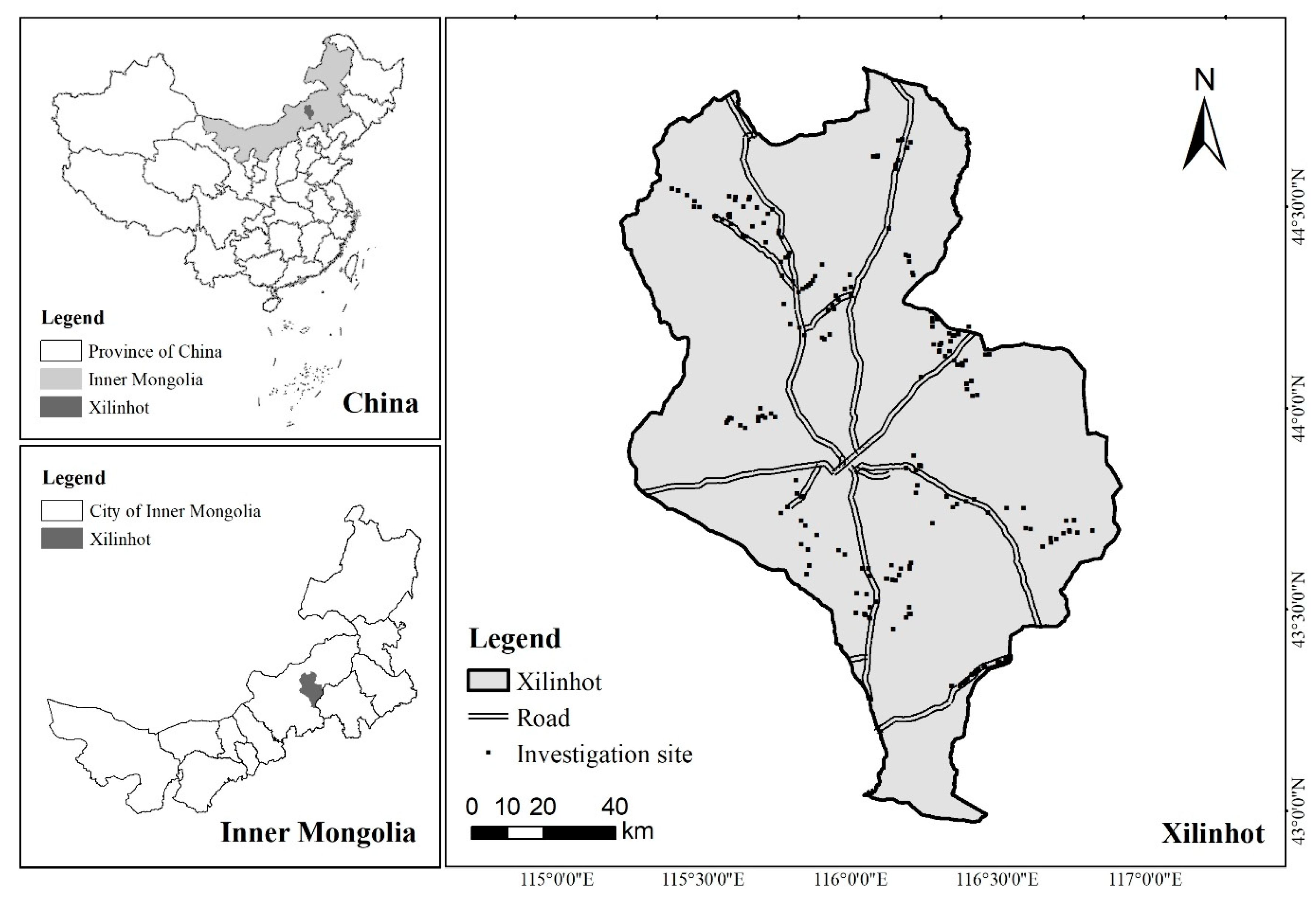
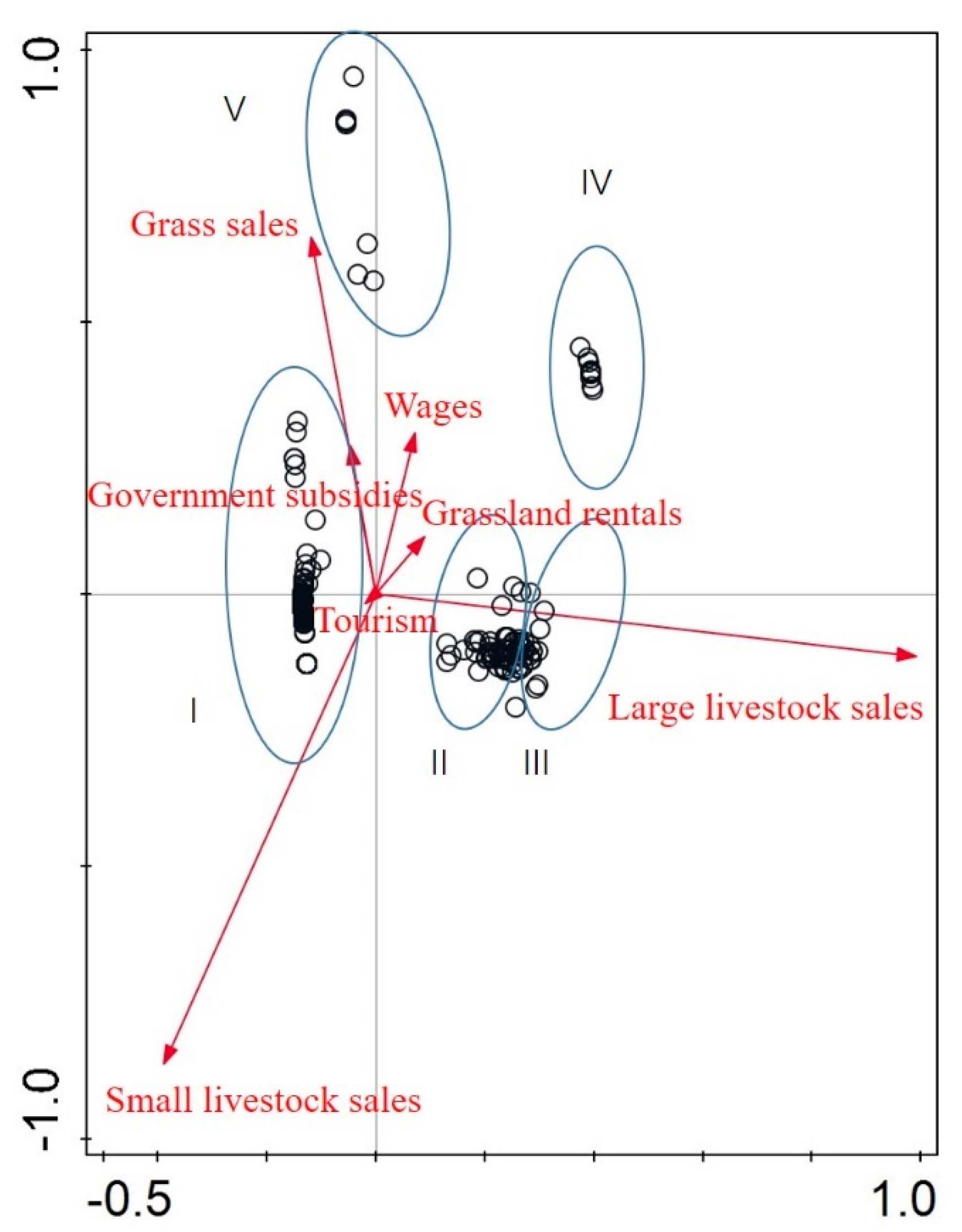
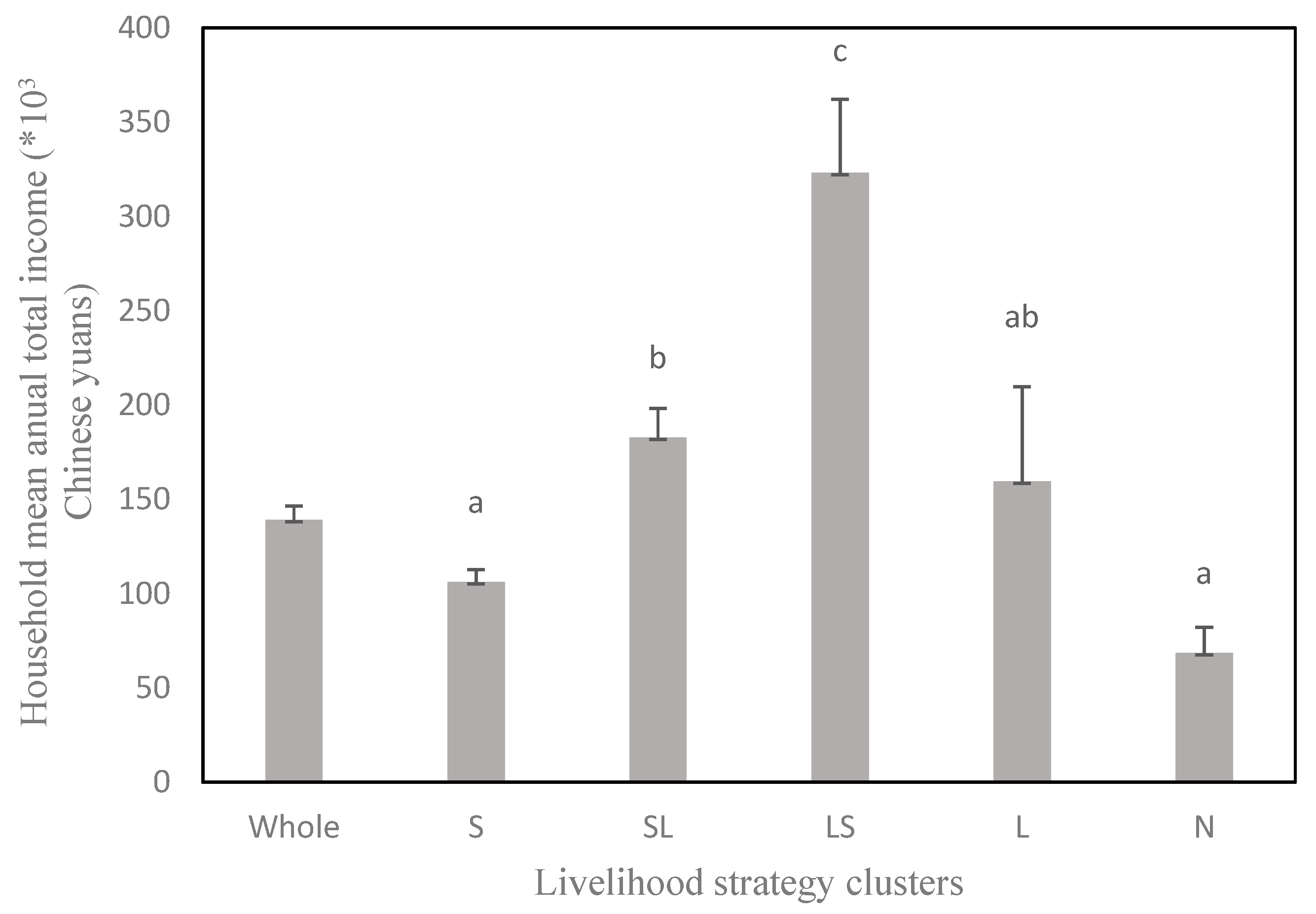
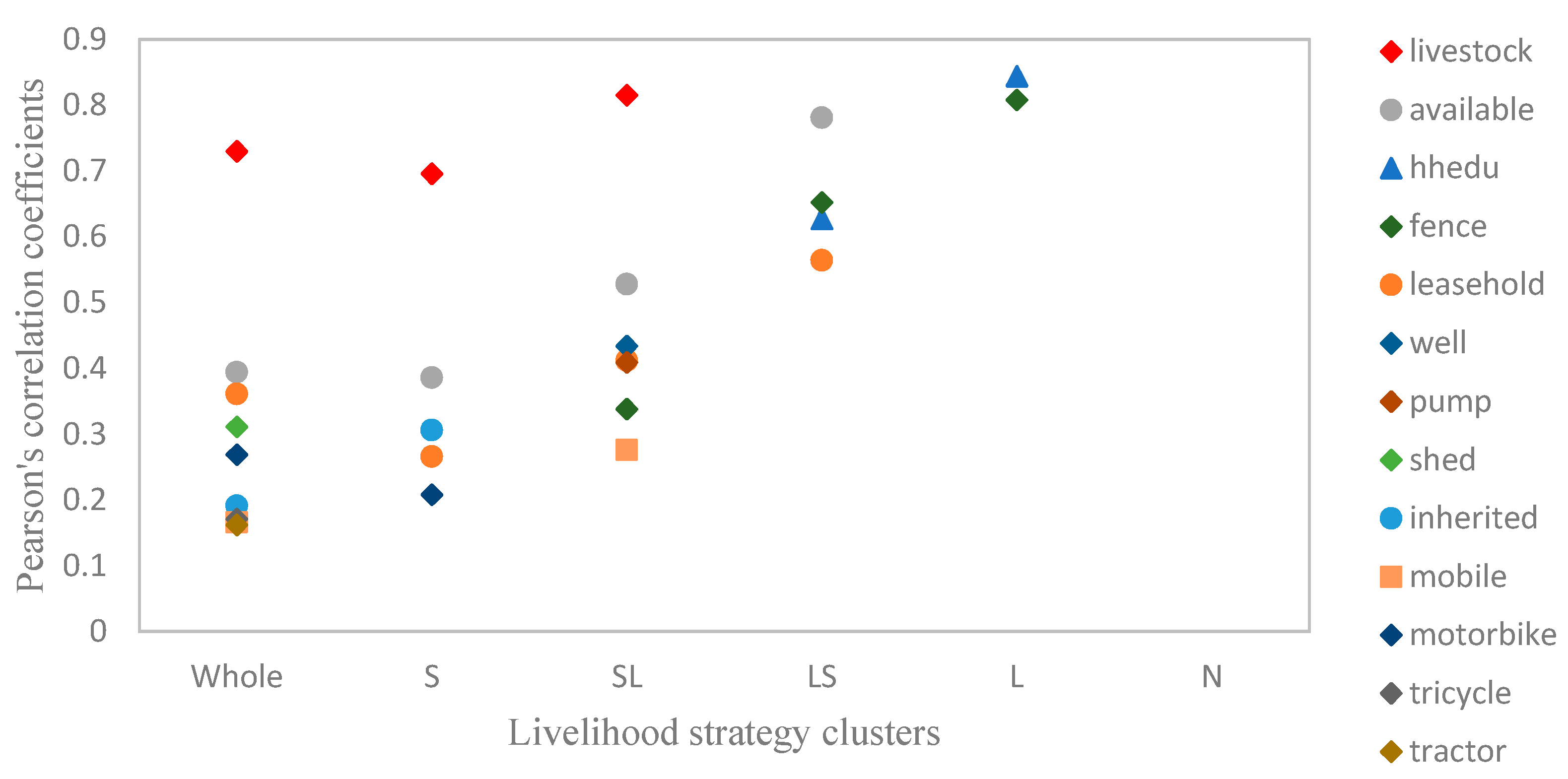
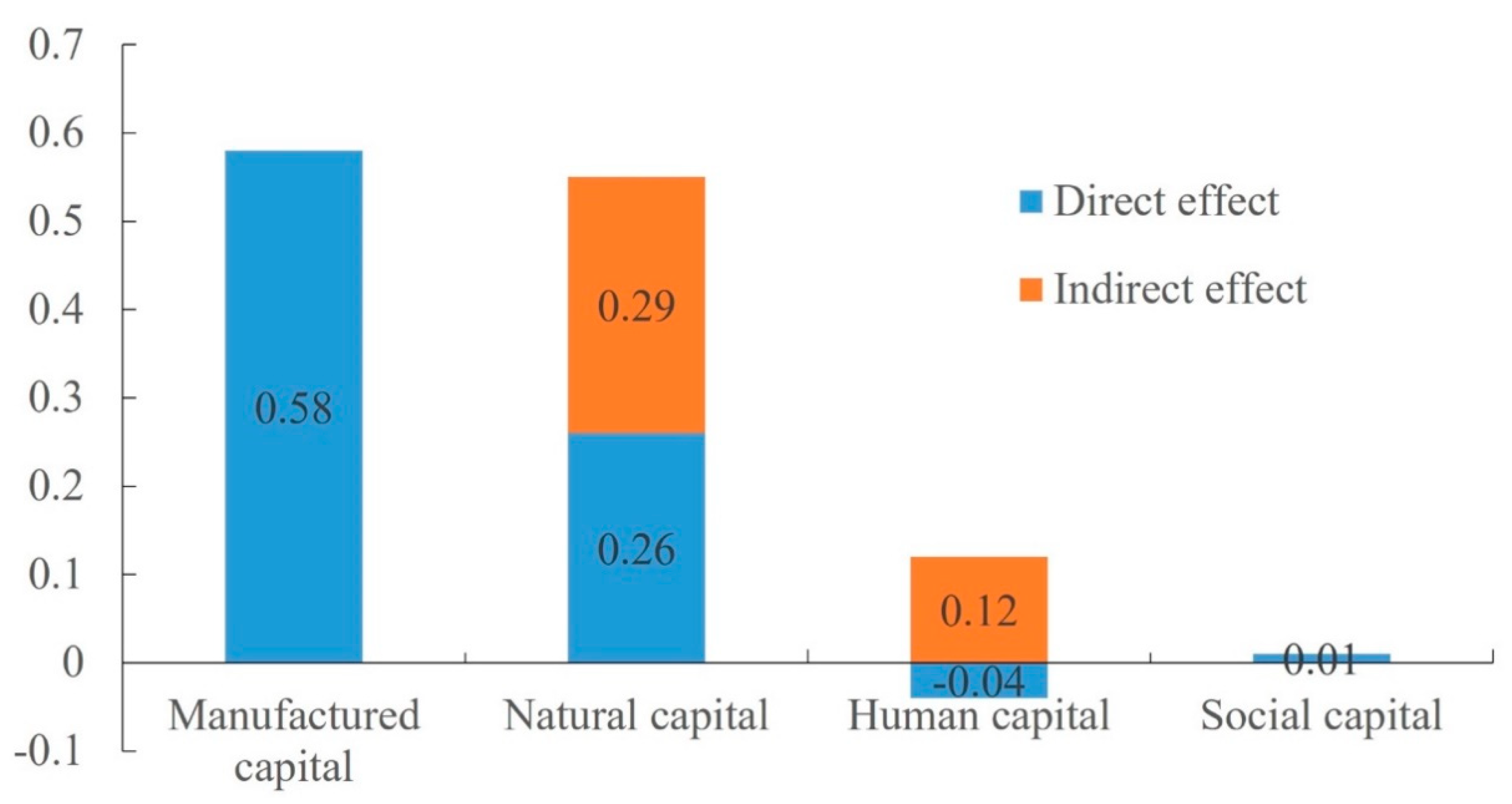
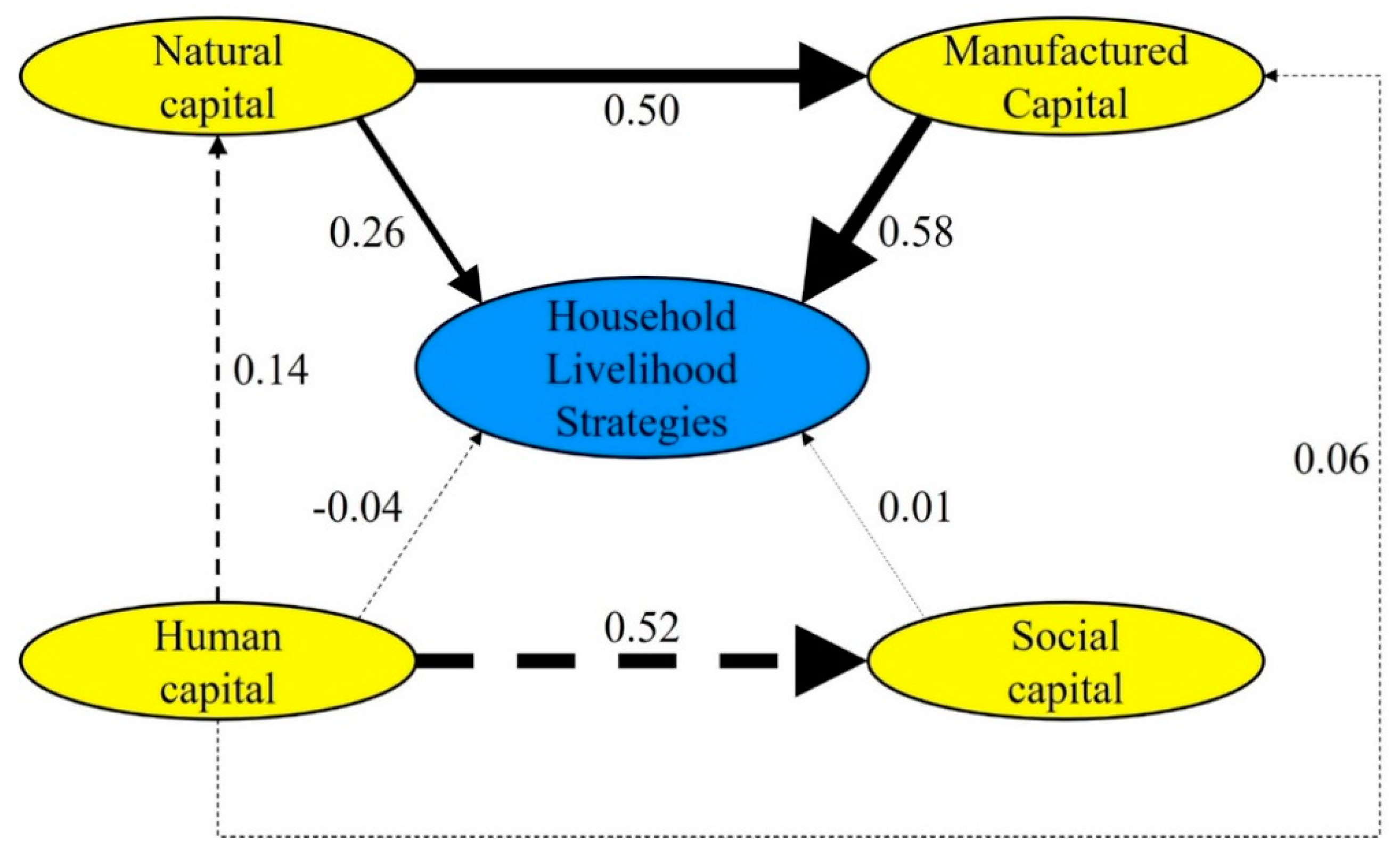
| Livelihood Capital Variables | Meaning | Scale | Literature |
|---|---|---|---|
| Natural capital | |||
| Inherited | Household’s inherited grassland area | Metric, in mu | [17,38] |
| Leasehold | Household’s leasehold grassland area | Metric, in mu | [17,38] |
| Available | Household’s total available grassland area | Metric, in mu | [1,39] |
| ALT | Altitude | Metric, in m | [11,14] |
| MAP | Mean annual precipitation | Metric, in mm | |
| MAT | Mean annual temperature | Metric, in °C | |
| Admin | Administrative | Qualitative, number 1 to 8 represent different counties | |
| Human capital | |||
| hhsize | Number of people in household | Metric, in persons | [39,40] |
| hhlabor | Number of household member older than 16 and younger than 60 years old | Metric, in laborers | [41,42] |
| hhage | Age of household head | Metric, in years | [14,17] |
| hhgender | Gender of household head | Qualitative, male = 1, female = 2 | [43] |
| hhethnic | Ethnicity of household head | Qualitative, Han = 1, Mongolian = 2 | [44] |
| hhedu | Education level of household head | Qualitative, illiteracy = 1, primary school = 2, junior high school = 3, technical secondary school = 4, high school = 5, college = 6 | [19] |
| Manufactured capital | |||
| Shed | The area of breeding sheds | Metric, in m2 | |
| Well | The number of wells | Metric | |
| Pump | The number of pumps | Metric | |
| Tricycle | The number of tricycles | Metric | |
| Tractor | The number of tractors | Metric | [45] |
| Motorbike | The number of motorbikes | Metric | [13] |
| Fence | The length of fences | Metric, in m | |
| Livestock | The number of livestock units owned by household | Metric, in sheep units | [46] |
| Social capital | |||
| Mobile | The number of mobile phones | Metric | [36] |
| Financial capital | |||
| Loan | Household’s total loan amount | Metric, in Chinese yuan | [35] |
| Livelihood Capitals | S | SL | LS | L | N | Average |
|---|---|---|---|---|---|---|
| Natural capital | ||||||
| Inherited | 3082.25 a | 4117.64 b | 1939.71 a | 2090.00 a | 2758.75 ab | 3177.45 |
| Leasehold | 1552.68 a | 1797.74 ab | 2444.12 ab | 3392.00 b | 187.50 a | 1700.46 |
| Available | 4632.25 a | 5896.51 b | 4348.53 ab | 5302.00 ab | 2760.00 a | 4855.91 |
| ALT | 1088.54 | 1103.24 | 1115.51 | 1148.51 | 1079.44 | 1095.86 |
| MAP | 293.06 a | 298.49 ab | 308.82 b | 305.40 ab | 308.36 ab | 296.37 |
| MAT | 1.80 | 1.80 | 1.79 | 1.80 | 1.80 | 1.80 |
| Admin | 4.67 a | 4.57 a | 2.53 b | 4.70 a | 4.75 a | 4.50 |
| Human capital | ||||||
| hhsize | 3.45 | 3.38 | 3.24 | 3.60 | 3.50 | 3.42 |
| hhlabor | 2.85 | 2.74 | 2.65 | 3.00 | 2.86 | 2.82 |
| hhage | 46.74 a | 48.23 ab | 46.35 ab | 49.10 ab | 52.88 b | 47.34 |
| hhgender | 1.17 a | 1.06 b | 1.18 ab | 1.10 ab | 1.25 ab | 1.15 |
| hhethnic | 1.50 a | 1.53 a | 1.53 a | 1.10 b | 1.38 ab | 1.49 |
| hhedu | 2.86 | 2.87 | 2.94 | 3.10 | 3.00 | 2.88 |
| Manufactured capital | ||||||
| Shed | 164.77 a | 217.70 bc | 276.76 b | 136.00 acd | 15.00 d | 178.14 |
| Well | 0.99 | 0.91 | 1.12 | 0.80 | 0.75 | 0.97 |
| Pump | 1.25 | 0.89 | 1.06 | 0.90 | 0.75 | 1.13 |
| Tricycle | 0.67 a | 0.75 a | 0.94 b | 1.00 b | 0.13 c | 0.70 |
| Tractor | 0.87 ab | 1.02 a | 1.06 ab | 0.90 ab | 0.50 b | 0.90 |
| Motorbike | 1.24 a | 1.43 bc | 1.76 bc | 1.40 ac | 0.63 d | 1.30 |
| Fence | 8448.37 | 9783.10 | 11448.24 | 8300.00 | 3250.00 | 8874.79 |
| Livestock | 399.90 a | 556.35 b | 604.88 b | 403.65 a | 13.44 c | 436.09 |
| Social capital | ||||||
| Mobile | 2.67 | 2.87 | 2.82 | 2.90 | 3.25 | 2.76 |
| Financial capital | ||||||
| Loan | 5.33 | 6.15 | 5.06 | 9.00 | 5.25 | 5.64 |
| Samples | Standardized Regression Coefficients | R2 (Adjusted) | ||||||
|---|---|---|---|---|---|---|---|---|
| Inherited | Available | ALT | MAP | Hhethnic | Hhedu | Livestock | Combined | |
| Whole | 0.128 * | −0.299 ** | 0.436 ** | 0.710 ** | 0.600 (0.592) | |||
| S | 0.696 ** | 0.485 (0.482) | ||||||
| SL | 0.771 ** | 0.720 (0.709) | ||||||
| LS | 0.930 ** | 0.350 * | 0.709 (0.668) | |||||
| L | 0.844 ** | 0.712 (0.676) | ||||||
| N | ||||||||
© 2020 by the authors. Licensee MDPI, Basel, Switzerland. This article is an open access article distributed under the terms and conditions of the Creative Commons Attribution (CC BY) license (http://creativecommons.org/licenses/by/4.0/).
Share and Cite
Liu, Y.; Zhang, Q.; Liu, Q.; Yan, Y.; Hei, W.; Yu, D.; Wu, J. Different Household Livelihood Strategies and Influencing Factors in the Inner Mongolian Grassland. Sustainability 2020, 12, 839. https://doi.org/10.3390/su12030839
Liu Y, Zhang Q, Liu Q, Yan Y, Hei W, Yu D, Wu J. Different Household Livelihood Strategies and Influencing Factors in the Inner Mongolian Grassland. Sustainability. 2020; 12(3):839. https://doi.org/10.3390/su12030839
Chicago/Turabian StyleLiu, Yang, Qing Zhang, Qingfu Liu, Yongzhi Yan, Wanxin Hei, Deyong Yu, and Jianguo Wu. 2020. "Different Household Livelihood Strategies and Influencing Factors in the Inner Mongolian Grassland" Sustainability 12, no. 3: 839. https://doi.org/10.3390/su12030839
APA StyleLiu, Y., Zhang, Q., Liu, Q., Yan, Y., Hei, W., Yu, D., & Wu, J. (2020). Different Household Livelihood Strategies and Influencing Factors in the Inner Mongolian Grassland. Sustainability, 12(3), 839. https://doi.org/10.3390/su12030839






